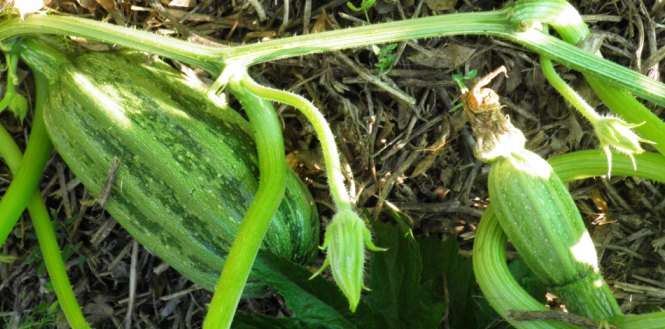[Recipe: Gokpinar Kabak - a Turkish take on a NZ treasure]
The long, hot summer in Lyttelton this year has meant that our garden is going gang-busters! One crop that is doing particularly well in the dry, sunny conditions is our kamo kamo (sometimes called kumi kumi). It is taking over the garden rapidly and is just bursting with glorious yellow flowers and speckled green fruit.

Kamo kamo is a uniquely New Zealand heritage vegetable that we see too infrequently in our supermarkets and greengrocers. It is a type of squash that is closely related to marrows, courgettes, and gourds. Like a courgette or marrow, it has a mild taste, but to my mind, it is far superior as it has a subtle, nutty flavour that stands it apart from its blander relatives. It’s also very versatile. Try it pan-fried, as tempura, barbequed, boiled, roasted, add it to stir fry, mash it or make fritters, chips or even relish from it. The young fruits are best eaten like courgettes, while the larger mature fruits are better cooked like a marrow and are great roasted or boiled. The male flowers and vine tips can also be eaten. Boiled and mashed kamo kamo makes a nutritious, safe baby food. It is rich in potassium, zinc and dietary fibre and has high levels of fructose and glucose.

Graeme introduced me to kamo kamo when we were students. He remembers eating them as a child on the East Cape, mixed in with kumara, potato and other vegetables in the hangi basket. In fact, kamo kamo are a tāonga crop and Māori have long been its custodians. It is thought to have been introduced into New Zealand in the late 1800s by European settlers, but it was Māori who valued it most and it quickly became a staple of their gardens and diet. They also used the hollowed and dried large fruits to store other foods. Even today, the seed stocks in some areas are closely guarded to ensure the integrity of different customary varieties. Two main varieties are distinguishable to those of us with less knowledge: one that produces round, pumpkin-shaped fruits with deep ribbing on the outside and a more elongated variety in which the ribs are less pronounced. Ours are of the elongated type.
In a small village called Gokpinar, in the south of Turkey I learnt how to cook the following dish with their version of kamo kamo. It is called Kabak in Turkish and is also more like the elongated version. Don’t be fooled by the simplicity of the dish- it is surprisingly more-ish.
Gokpinar Kabak
Peel the kamo kamo and scrape out any big seeds from the centre. Then grate the flesh on a hand grater or on a big setting in your food processor. Put 2 tablespoons of a nice olive oil into a frypan heated to medium. Add the grated kamo kamo and cook it gently until it is soft. Meanwhile mash up a clove or two of garlic in a mortar and pestle and add half a cup of yoghurt. Stir it together with a pinch of salt. Stir this yoghurt mix into the kamokamo and put onto a serving plate. Sprinkle some dried mint and a little chilli flakes on top.

